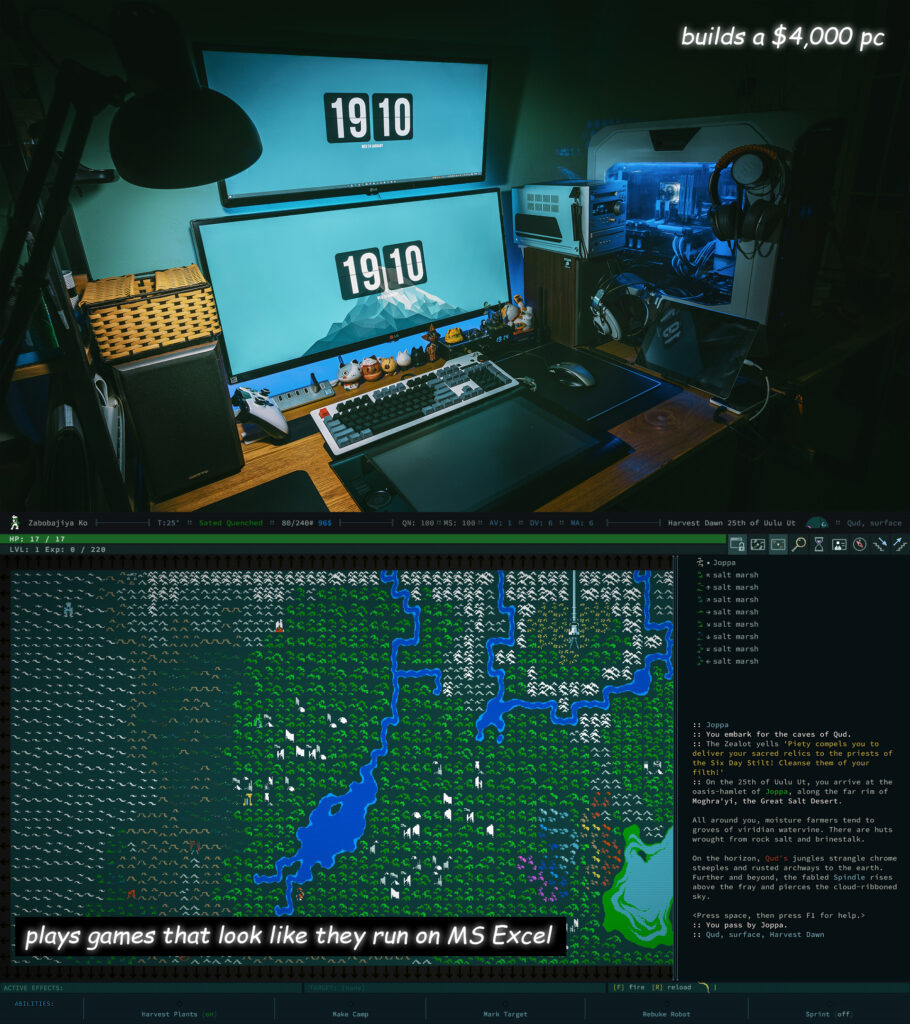
Week 2 – Mini Assignment 1 – Topical Meme


A MEME This meme accurately describes the situation of me and many of my peers. I overheard a few people…
A MEME

This meme accurately describes the situation of me and many of my peers. I overheard a few people talking about how they suddenly lost their momentum of keeping up with two weekly posts. I could relate and found myself in the same boat as them as this semester’s workload just doubled out of nowhere. Where did 2 midterms, 1 project, weekly posts and three canvas quizzes suddenly come from? I had a good track record of doing all my posts on time but I think I missed one week of posts as there was no class and I just worked on my website instead of writing posts. I have caught up on my posts now and just have one content and one process post left for this week which I plan to do soon.
I think this mountain of work piling on was a wake-up call for me to not snooze and keep on grinding. The silver lining is that I did not get too behind on my posts and am still able to produce quality posts in time before the peer review and marking by the TA.
I am excited to write two of my posts soon after I do the readings as I really enjoy the area of publishing and website design in general.
The Motorola Moto G54: Redefining Affordable Excellence In the ever-evolving world of smartphones, where new models are constantly released with…
In the ever-evolving world of smartphones, where new models are constantly released with newer features, the Motorola Moto G54 has made quite a name for itself. This is an affordable powerhouse which has garnered popularity among users worldwide due to its impressive features, sleek design, and budget-friendly price point. In this article, we will delve into the remarkable features of the Motorola Moto G54 and explore why it has become such a beloved choice for consumers, including being used by my dad.
One of the first things that struck us about the Motorola Moto G54 is its sleek and modern design. The phone features a large and vibrant display with a minimalistic design that allows for an immersive viewing experience. The build quality is exceptional, offering a sturdy feel in the hand, which is rare for a smartphone in its price range. With a choice of eye-catching colors and a well-thought-out design, the Moto G54 stands out in a sea of generic budget smartphones.
The Motorola Moto G54 comes with a generous 6.8-inch Full HD+ display. Another evident reason my dad thought of going with this phone is the large screen size which is perfect for media consumption, gaming, and browsing the web. With vibrant colours and sharp details, the device honestly offers an enjoyable visual experience that’s typically reserved for more expensive models. Whether you’re watching your favourite TV show or playing graphic-intensive games, the Moto G54’s display won’t disappoint.

Under the plastic, the Moto G54 is equipped with a powerful Qualcomm Snapdragon processor, ensuring smooth multitasking and lag-free performance. I have personally navigated through multiple apps, edited photos, and played graphics-intensive games on this phone, and it handled it all with ease. This processing power, combined with ample RAM and storage options, ensures that the device remains responsive, snappy and does not overheat.
Speaking about the battery, the Moto G54 comes with a robust battery life that can easily last a full day of heavy usage. You can count on the device to keep you connected and entertained without constantly searching for a charger. In the age of fast-paced lifestyles, a reliable battery is a crucial feature for a smartphone, and the Moto G54 delivers worry-free on this front.
Even though the camera was not a deciding factor when we purchased this phone, Motorola has equipped the phone with an impressive camera setup. The rear camera features a high-resolution sensor with multiple lenses, ensuring that the user can capture detailed and stunning photos. Whether it’s used for amateur photography or simply wanting to document one’s daily life, the Moto G54’s camera is up to the task. Plus, the device offers various camera modes and features to enhance your photography skills!
One of the standout features of the Moto G54 is its clean and bloatware-free Android experience. Motorola’s commitment to a full Android interface ensures a clutter-free and user-friendly environment. This not only enhances the overall user experience but also results in faster software updates.
Price-wise, the Moto G54’s competitive pricing is perhaps one of its most significant selling points. It offers a variety of premium features without the premium price tag, making it accessible to a wide range of consumers. In a generation where flagship smartphones can often cost a kidney, the Moto G54 provides an attractive alternative without sacrificing performance and functionality!
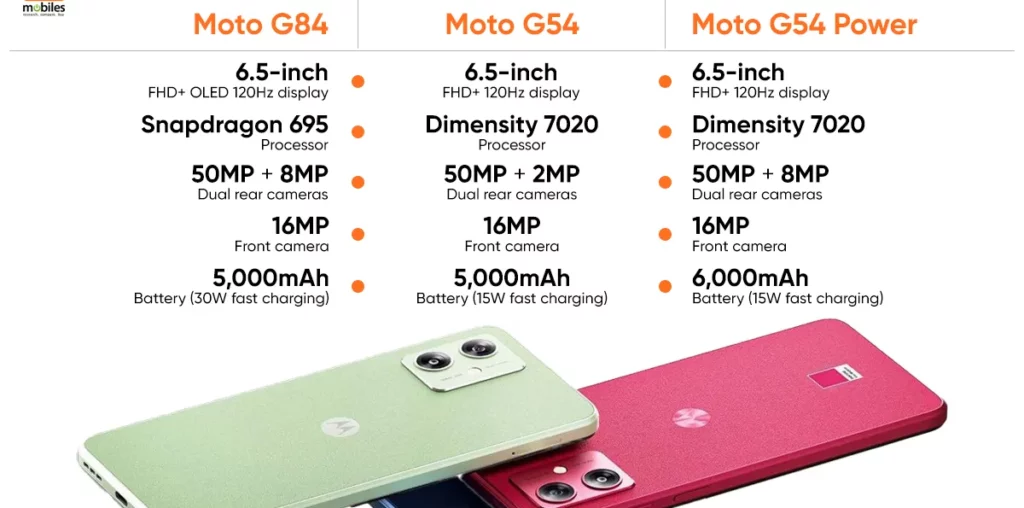
So, in our opinion, the Motorola Moto G54 has earned its popularity by combining an appealing design, stunning display, powerful performance, long-lasting battery life, and a competitive price point. For people looking for a smartphone that offers an impressive bang for their dollar, the Moto G54 is a top contender. Its success is proof of Motorola’s dedication to providing a quality smartphone experience at an affordable cost. Whether you’re a budget-conscious consumer like my dad or simply seeking excellent value (also like my dad), the Moto G54 is a strong option that doesn’t compromise on features or quality.
Learn more at:
https://www.motorola.com/we/smartphones-moto-g-54-5g/p?skuId=538
What do you get when you combine Quake, Vampire Survivors, and a fascination for Vlad the Impaler? Impaler (the game) is an indie roguelite, arena survival, boomer shooter running on a custom engine; where you’re tasked to clear waves of oncoming monsters in a large cathedral room – doing your best to survive each onslaught […]
What do you get when you combine Quake, Vampire Survivors, and a fascination for Vlad the Impaler? Impaler (the game) is an indie roguelite, arena survival, boomer shooter running on a custom engine; where you’re tasked to clear waves of oncoming monsters in a large cathedral room – doing your best to survive each onslaught thrown your way. The game currently sits at a price point of $3.89 CAD and is created by a small studio known as Apptivus. It seems to be their only PC title so far – their prior endeavors being in the physical toy and mobile app space.
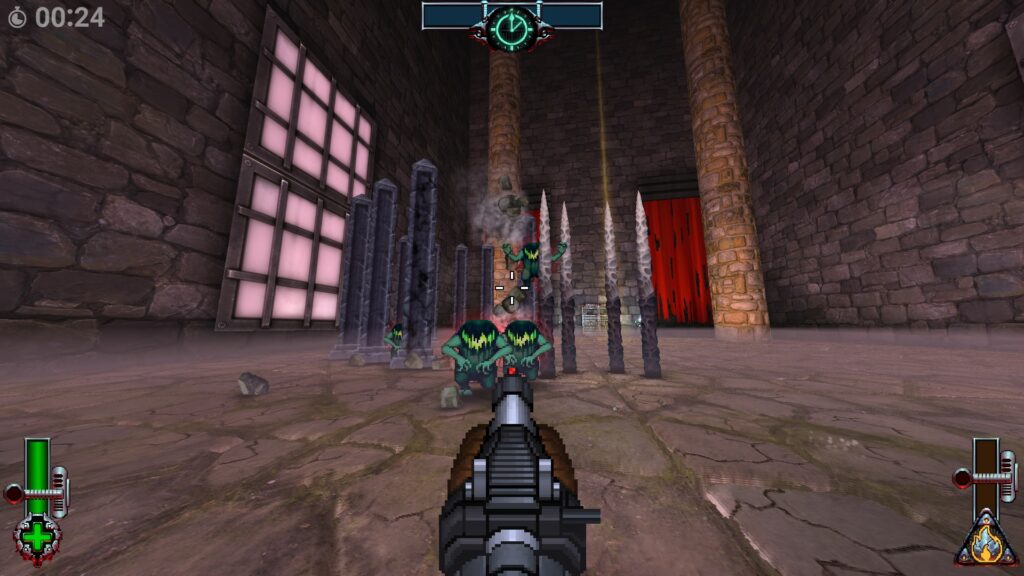
The gameplay loop is simple, players are given the choice of a primary starting weapon, along with the default secondary weapon known as “the Impaler” – although I find this weapon functions more as the player’s primary weapon as the core mechanics revolve around its projectiles. The first time you play the game, you can only choose the first weapon, the Perforator, which functions as an SMG; so, I selected this and began the brief tutorial.
Primary weapons function intuitively, SMGs/ARs shoot a stream of bullets, shotguns shoot in slow bursts, launchers shoot even slower with more damaging projectiles and the single sword allows you to melee nearby enemies while also firing a slash of energy to hit anything at a distance. All these attacks are bound to the left mouse button by default.
Where the game shines, however, is the Impaler. Players can hold down the right mouse button to show a targeting circle and press the left mouse button to create a spike that shoots up from the ground, impaling anything unfortunate enough to be above that location. This weapon can also be used defensively, as the spikes persist in the arena and can be used to form obstacles for the enemies. Furthermore, they can be used to launch the player into the air allowing for vertical navigation throughout the arena.
While there is no reloading, both the primary and secondary weapons have an overheat meter, which builds with each subsequent shot and will briefly prevent the player from firing if filled.
With a trusty weapon selected, players are thrown into the rectangular arena where a wave of monsters spawns, along with various environmental obstacles which can be destroyed and pushed around. Furthermore, each level spawns three “goblet” which can be pushed towards a glowing circle; exploding into coins and occasionally health for the player to collect. Monster kills drop coins for the player and small bundles of health if killed with the Impaler. Once all monsters are killed, the room despawns all the obstacles and provides players with coins or health – the coins only spawning if the player completes the level with a full health bar. You then step into the center of the arena and the loop starts again with a new layout and a new set of enemies – however, if you have enough coins, you are given a choice of two upgrades prior to starting the stage.
The upgrades appear in seven categories:
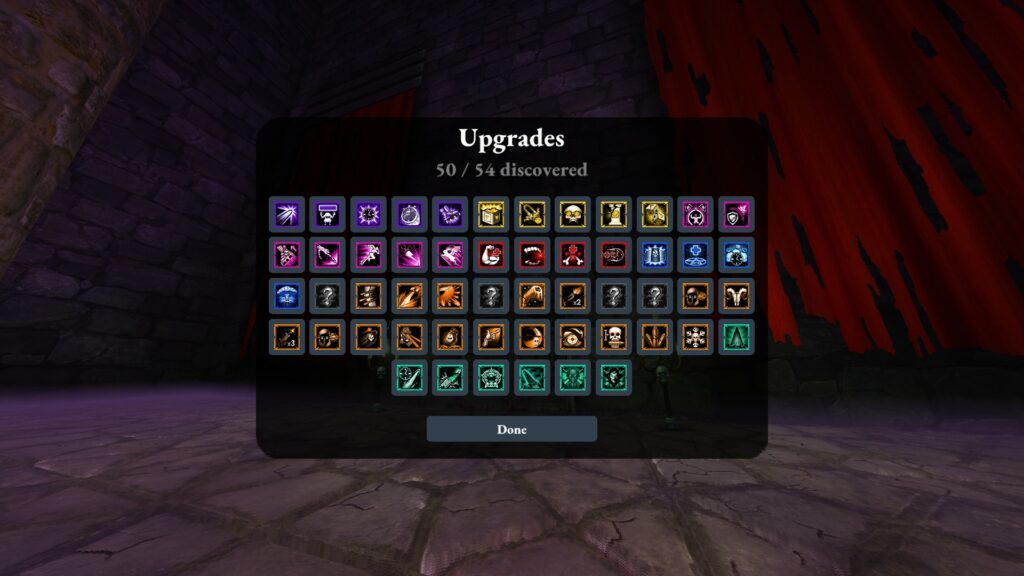
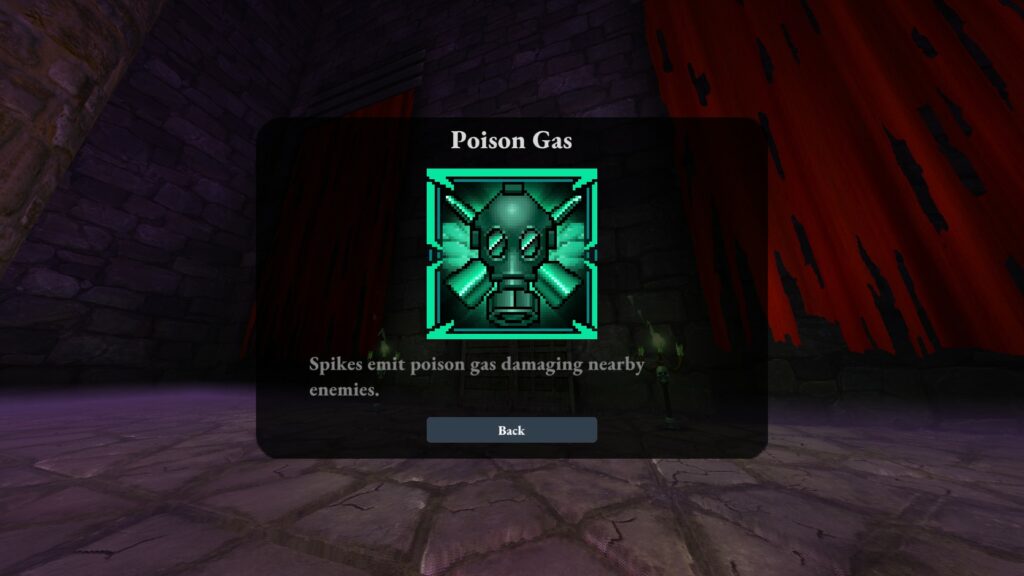
Weapons are unlocked by completing various challenges such as achieving a total number of kills, achieving a number of kills by impaling enemies or killing a certain number of enemies with environmental hazards. There are eight total weapons:
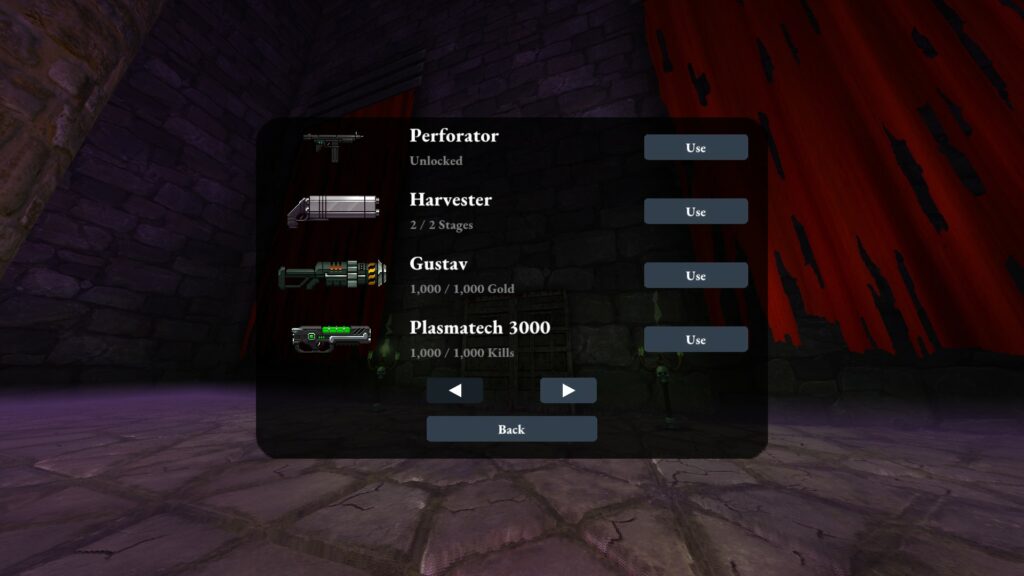
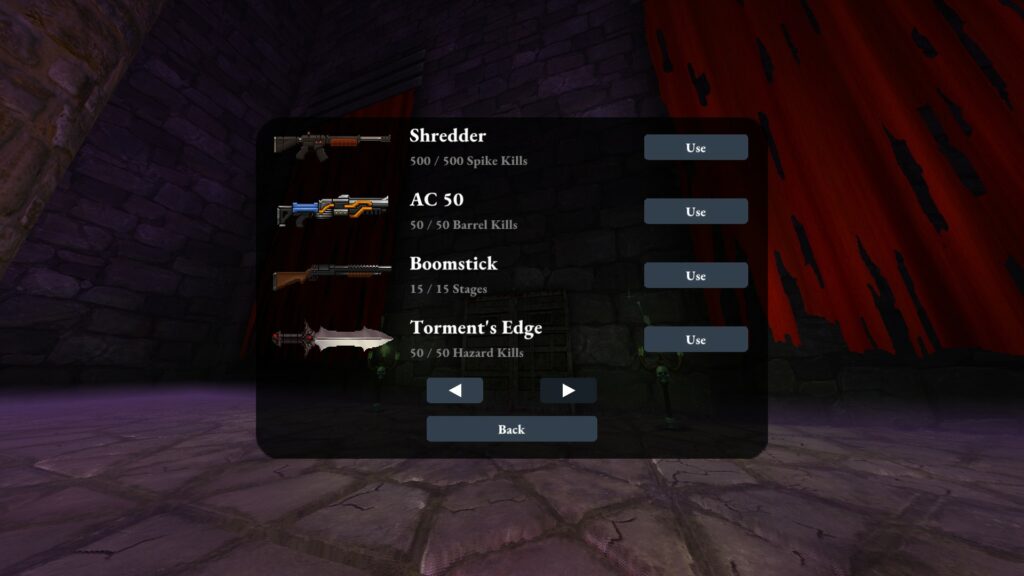
Starting off my first run, I immediately appreciated the simplicity of the tutorial. The game goes over basic mechanics such as shooting your primary weapon and impaling enemies. It covers the stomp attack that occurs when you land after a high jump and details that enemies can also be killed by jumping on their heads. And lastly, it details that goblets can be pushed into rings of light by walking into them to launch them into a certain direction. With the basics covered, the game put me right into the action.
The UI is simple yet effective, it hardly takes up any screen space, detailing the player’s health, overheat status and number of coins collected. Below the coin counter there is also a meter showing the player how close they are to their next upgrade.
Movement feels crisp and responsive, a must for a fast-paced boomer shooter. Players can strafe and bunny hop to increase their momentum, double jump to avoid obstacles and even rocket-jump – or spike jump in this case – by shooting the Impaler directly below your feet. Successfully initiating a spike jump will allow release an AOE burst of damage around the player when they land.
My first run felt relatively easy, enemies spawned in cages, giving players a moment to plan their next move before being rushed. Each stage introduced new enemies with various mechanics – some of the basic enemies rushed me and were easily disposed with the Impaler, while other enemies were airborne or atop tall pillars requiring me to spike jump and get in a favorable position to take them out with the primary weapon. While the entire game takes place in a single room, I appreciated the variety of level layouts as each new stage removed the previous obstacles and set up new ones. As the game progressed, environmental hazards began to appear such as sawblades moving from one end to the other on one axis, or laser beams moving across the arena in two axes.
Upgrades felt plentiful, having a choice provided after almost each stage. I decided to dump all my upgrades into the Impaler spikes – finding that survivability boosts didn’t feel necessary. Similarly, I found myself hardly strafing nor bunny hopping as basic movement combined with spike jumps were more than enough to survive. This strategy ultimately paid off as I managed to get to the final boss and beat it.
The final boss itself – a massive floating skull stationary in the middle of the arena – felt lackluster. The arena setup was fairly open allowing me to freely fly around the arena with spike jumps and avoid all enemies. Furthermore, waves of enemies kept spawning, allowing me to kite them and impale them in groups to infinitely refill my health with their drops. Upon firing at the boss, I realized there weren’t any damage indicators, instead a graphic bubble floated above its head instructing me to stomp on it. Using the various jump pads in the arena, I quickly caught on and began my aerial assault – taking me back to the days roleplaying a certain Italian plumber stomping on unexpecting turtles. Each successful stomp spawned explosive barrels around the boss, which needed to be destroyed prior to the next stomp. After four or five stomps, the boss was defeated, and a victory screen appeared, notifying me that a new difficulty had been unlocked.
There wasn’t much strategy involved in my first run, I hardly felt overwhelmed and allowed myself to grasp the various mechanics while getting used to movement. It was only when I began playing on hard that I felt the game truly required a mastery of all it’s mechanics. Starting the game anew, I chose a different weapon, the Harvester shotgun pistol. Truthfully, this felt like a downgrade from the default weapon, thus, I once again relied primarily on the Impaler. I made it half-way through a full run before eventually getting overwhelmed and dying.
Nonetheless, I started to pick up on more of the game’s mechanics. Previously acquired upgrades were now shown in detail, while ones that I had yet to choose were still a mystery – this along with the weapon unlocks now made the progression clear. The more runs I played; the more planning would be available for future runs as I now knew what each upgrade provided; this allowed for careful selection to create synergies. I noticed that there were variations of the goblets that would spawn, some being basic golden goblets, others having a cross on them, and the third variant featured a demonic face – despite noticing this, I had yet to understand their varying significance.
I tried a few more runs on hard, each being unsuccessful; however, as weapon unlocks came easily, they allowed me to experiment with the armory and figure out which best suited my playstyle.
Ultimately, I’d argue that the most effective weapons were the fully automatic ones – the Perforator, the Plasmatech, and the Shredder as they didn’t have a long wait time between shots and allowed me to take out flying enemies from a distance. The last being the most important aspect of these weapons, as I found the flying demons and the enemies positioned atop pillars to most dangerous and prioritized them above all the others. The shotguns required putting myself in positions where the danger outweighs the potential damage. Similarly, while launcher allowed me to target enemies at a distance, the rate of fire was far too slow – even with upgrades – and often got me overwhelmed and overrun.
Nonetheless, like any good roguelike/roguelite, each subsequent run I noticed myself getting better – mechanically and strategically. Emergent mechanics became clear, I was now able to time my spike jumps in combination, shooting the next spike inches ahead of my position and just before landing to launch myself once more and stay airborne. I learned the significance of the goblets – basic ones would explode into coins when pushed to their target, cross goblets exploded into health and coins, and most importantly, the I noticed the demon goblets would suck up any coins or health pickups in the arena, removing them from play. With this new knowledge, prioritization played an even more important role. Previously, if I felt overwhelmed by monsters I could ignore the goblet in play – sacrificing some gold to ensure my survival. Now, I would need to effectively kite enemies while pushing demon goblets onto their targets to ensure my run progression isn’t halted – more importantly, to ensure my health pickups weren’t being removed from the arena.
The more I played, the more I found myself getting into the “dance” of floating around the arena with quick reactions. I later discovered that once you kick a goblet, you can shoot it while it’s midair to push it even further – this allowed me to quickly dispatch goblets and turn my attention to the oncoming enemies. Even later, I learned that I could impale a goblet with a spike to get it airborne, then shoot it to further push it into that direction. I no longer needed to run up to the goblets to begin moving them around – two clicks from across the arena had the same effect.
After about five hours, I felt as if I was able to effectively combine all available mechanics to weave my way through enemies, collect the most amount of coins and consistently avoid damage. My previous point opinion on weapon types held up as I successfully completed a full run – and beat the final boss on hard.
This now unlocked the nightmare difficulty, which I gave a few tries, however, ultimately the artificial difficulty of this mode took away from the fun. Basic enemies became bullet sponges, while the rest of the mechanics worked the same. While I’m sure it’s still possible to beat the game on nightmare with a strong set of upgrades, it felt like a chore compared to the previous difficulty.
One mechanic I hadn’t discussed was the leaderboard system. The game counts scores based on the types of kills a player gets throughout their run, multiplied by their chosen difficulty. Only a few hours into the game I found myself in the top 500 players (out of 6615 total players) with my successful run on hard. The gap between my current position and being in the top 100 is quite small, and I believe I can reach a spot in the top 100 with a win on nightmare.
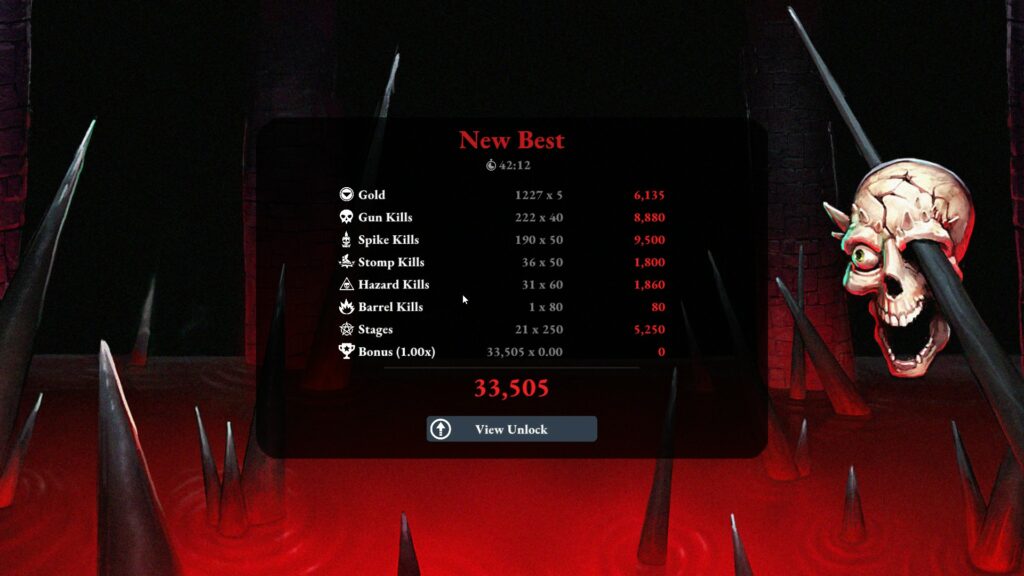
Reflecting on the game objectively, I do hold some criticism. As previously mentioned, the final boss feels far too easy when compared to some of the normal stages that must be completed to get there. It relies on overwhelming the player with basic enemies (that can be dispatched easily) and takes the focus away from the movement required to survive regular stages – and the movement is arguably the best part of this game. A missed opportunity in my opinion. Furthermore, the environmental hazards (not obstacles) seem far too damaging. I could be 30 minutes into a run, only to find my health bar fully depleted by standing in a laser beam for a fraction of a second. Lastly, the leaderboard system unnecessary as scoring seems slightly arbitrary with the player relying on random upgrades. I wouldn’t say I felt a sense of accomplishment seeing my position climb as in other games like Devil Daggers or Hyper Demon. Lastly, while the graphical style is fitting, the 2D sprites of enemies which always face the player makes the stomping mechanic feel off – often times missing by an inch due to lack of depth of enemy models and hitboxes.
Overall, this game was a pleasant surprise. For such a small price the potential play time and fun is unmatched. Although minimal, the game weaves its mechanics into a beautiful combination making the player feel like the demon slayers of classic shooters – bobbing and weaving between monsters and soaring through to skies to demolish enemies from above. The discovery of emergent mechanics combined with the lack of instructions allows for a sense of discovery and constant improvement. The roguelike elements with random upgrades certainly encourage replayability, however, feel overshadowed by the core mechanic of the self-titled Impaler gun. The game truly shines from its use of movement and spike jumping and feels like a mechanical delight. I would recommend Impaler to any fans of doomer shooters.
This week’s lecture was about the online self. When thinking about what is the self, one might asking questions such as; who am I, what is my voice, do I recognize it? In the lecture, we worked based on John Suler’s article “The Online Disinhibition Effect” from 2004, an article that gave some valuable and […]
This week’s lecture was about the online self. When thinking about what is the self, one might asking questions such as; who am I, what is my voice, do I recognize it? In the lecture, we worked based on John Suler’s article “The Online Disinhibition Effect” from 2004, an article that gave some valuable and valid points. Among these, I found both the positive and negative disinhibition aspects interesting. Reflecting upon it, there are so many layers of the positive and negative behavioural changes. For instance, people on the internet tend to often feel more comfortable to express themselves and share personal information online, because they can hide behind a screen, which can lead to increased openness. At the same time, can the hiding behind a screen lead to bullying and aggression.
In the lecture, I learned a new term called ‘solipsistic introjection’. When the concept of solipsistic introjection was explained to me, it became clear what it means. I simply did not know that the concept existed to describe that ‘action,’ or whatever you want to call it. Furthermore, I got familiar with the term ‘dissociative imagination’, which combines the solipsistic introjection with the escapability of the online world magnifies disinhibition. An example of this could be a violent videogame, where there is no psychical threat as it is “just a game”.
Overall, it was an informative lecture in terms of concepts, as I was introduced to many new and interesting ones. Looking at my website, I am still struggling to get it to work optimally. It lacks on finish and personality in the form of appearance, and it needs better content structure and organization. However, I got some buttons to work today that were not working yesterday. And as long as I am making progress, even if it is small steps, it is a positive thing.
This is not one. Man, memes are difficult to execute successfully. What a wonderous culltural phenomenon. Luckily imgflip.com is quicker than photoshop!
This is not one. Man, memes are difficult to execute successfully. What a wonderous culltural phenomenon. Luckily imgflip.com is quicker than photoshop!

Q: Write a blog post about the work you did this week. How does what you’ve created so far relate to the vision board you …
I will be completely honest in saying I really struggled to grasp the straws of what was necessary to work on our blog. There is so much freedom in the assignment that I feel like a fish out of water, flailing to identify what is good and necessary to fulfill what required of me. I definitely visited the semantics of WordPress because it is also something completely new to me and left me baffled and confused. I wish I also had more technical support on how to navigate and best organize the blog.I’m behind because I haven’t been able to decide the theme of the blog. I know what I will have the easiest time producing content about is kpop because that is a huge hobby of mine. However I don’t know how profound that content will be, and honestly I feel somewhat embarrassed at the thought of peer reviewing something that’s so personal to my interests. It feels sort of… silly.
I basically have two branches. I stick to a kpop group stan blog, sprinkled with Korean cultural commentary. Or I drop kpop all together and focus of social critique of online spaces and the kpop industry, none of my own interests in kpop reflected in the blog. What a dilemma.
Q: Reflect and comment on your stranger encounter. How did it differ from your online interactions? I find that my stranger encounter was a bit …
I find that my stranger encounter was a bit plain. I ended up going the most obvious route and speaking to someone in an elevator. To be completely honest I am painfully aware of how I am different online and in person. With my fair share of social anxiety, I often pull out all the stops to make the best first impression in every physical interaction I feel reflects on me as a person. I dare say I have made a formula of things that seem like “green flags” to strangers and act accordingly. I also am not much different online. Despite the anonymity of a faceless space I am no less of a people pleaser. But at least there, I have the freedom to leave.
An elevator traps you in bare minutes, caged by all the social norms one could ever name. It was awkward towards the end, and I spent a good 5 minutes overthinking it.
The first weeks of PUB 101
The first weeks of PUB 101

@sfupublishing, @learnpublishing #posiel

@sfupublishing, @learnpublishing #posiel
For week 2 session, the in-class activity for brainstorming about personal identity was really interesting.

For week 2 session, the in-class activity for brainstorming about personal identity was really interesting.